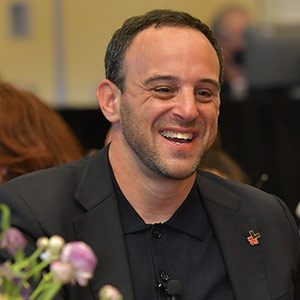By Rob Bates
As part of a new plan to increase the value and visibility of its name, De Beers hopes to eventually sell most of its diamonds with a code of origin that indicates the company mined them.
Executive vice president Stephen Lussier and chief brand officer David Prager announced the Code of Origin program during “The Power of Purpose-Led Brands: How Values Create Value,” which took place at the Marcello Ballroom at The Venetian Resort on Thursday at Luxury by JCK.
Each code of origin diamond will have a unique table inscription that will identify it as a natural, conflict-free gem that was discovered by De Beers in Botswana, Canada, Namibia, or South Africa.
That inscription, which will be available for diamonds of 0.3 ct. and up, is invisible and does not affect the stone’s clarity. It will be added, post-polishing, by its lab, the De Beers Group Institute of Diamonds. The diamonds’ provenance will be tracked using the “pipeline integrity” practices De Beers has developed for its Forevermark brand and could be eventually supplemented by its Tracr platform.

The code of origin program is still in “the learn-to-scale phase now,” says De Beers chief brand officer David Prager.
“We’re proceeding with caution, making sure that we’re learning from the pilots we have in the market. But we’ll be looking for development partners in 2022 and ramping up.”
Eventually, De Beers wants “the majority of the diamonds we mine to carry the code of origin,” Prager says. However, retailers and manufacturers can decide to sell them as regular diamonds if they wish.
He admits that in most other industries including origin information might not be groundbreaking.
“But in our industry, it’s pretty sizable,” Prager says. “For the first time we’re going to produce a product and we’re going to put our name on it and we’re going to sell it at scale.”
However, he stresses the new marked stones should not be considered De Beers–branded diamonds. He says the inscriptions act as a “trusted source mark.”
The code of origin does have some similarities to Forevermark (now De Beers Forevermark), which also started out as a “trust mark.” But Prager notes that there are additional selectivity criteria for Forevermark stones, and that brand is becoming more of a jewelry line.
He says that feedback from the initial pilots—which have so far taken place outside the United States—has been good, and that’s without extra promotion.
Still, Prager admits the code of origin won’t have much value unless consumers specifically seek out De Beers diamonds, and the company intends to put a lot of marketing muscle toward boosting the brand’s “fame and love.”
It plans an ambitious fourth quarter campaign built around its name, which now not only adorns its retail chain—and accompanying e-commerce platform—but also the newly christened De Beers Forevermark brand and backs up the code of origin.
De Beers also plans to spend more time talking about its new Building Forever program, which Prager calls a “mission, to do nothing short of protect the planet and improve people’s lives.”
As part of that program, De Beers has pledged $7 million to buy 500,000 COVID-19 vaccines for Namibia and Botswana and is partnering with National Geographic for Okavango Eternal, a new program to protect to Okavango Delta.
The Delta “is one of the most pristine wildernesses in the entire continent of Africa, in the entire world, and obviously key to the future of Botswana,” Prager says. “We’ve got the opportunity and the potential to provide food and water security for a million people, to provide livelihood opportunities for 10,000 people, and protect endangered species across the region.”
He says that younger consumers expect companies to engage in these kinds of efforts.
“There is compelling evidence that consumers are motivated to purchase based on your carbon footprint or the assurances you’ve given as a brand that you’ve done no harm,” Prager says. “But we also think [brands] need to be parts of a larger story. And the larger story is not that ‘I’ve done less harm to my competitor,’ but, rather, that ‘I’ve created a significant positive impact on people and the planet.’
“Consumers want to know the diamond they give for their most important moments and that they hold onto for decades, and hopefully one day pass on to someone they love, has made a significant impact on the life of somebody else as well.”
Of course, not everyone has been enamored with De Beers over the years. But Prager says that its research shows that people see it as an “authority” when it comes to diamonds but aren’t necessarily clear about the rest.
“There is a lot of open space in many cases,” he says. “Consumers are unsure about what De Beers stands for and what our story is and that’s why we think there’s an opportunity.”
Source: JCK 26-08-2021